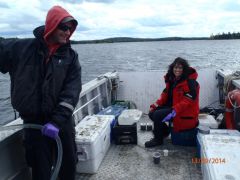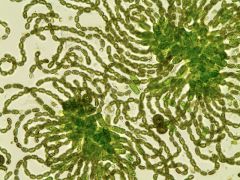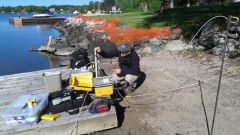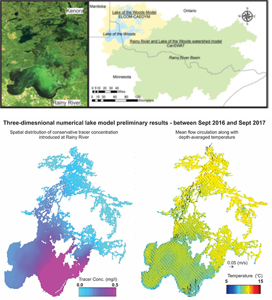Environment and Climate Change Canada’s (ECCC) Rainy River-Lake of the Woods Watershed Science Program 2016-2020
An integrated research and monitoring approach addressing water quality conditions and algal blooms in the Lake of the Woods watershed
ECCC’s Rainy River-Lake of the Woods Science Program focuses on enhanced monitoring and improving our understanding of lake conditions and processes. This work will inform solutions to improve water quality, and in particular, approaches to minimize harmful algal blooms.
Since 2016, ECCC researchers have been in the field conducting research to identify the causes and consequences of nutrient enrichment and harmful algal blooms. Researchers have also been building watershed and lake models to help predict the lake’s response to potential phosphorus reduction strategies.
ECCC researchers are collaborating with other agencies and organizations on both sides of the border to support the integration of all science activities and knowledge needed for the sound management of water quality in the Lake of the Woods.
For further information on ECCC’s Science program, please contact:

The second project uses an automated water sampler on the Pinewood R. and collects samples at regular time intervals during ice free conditions. Data from this project will contribute to the larger tributary monitoring effort by Catherine Eimers at Trent University.
 Satellites provide frequent lake-wide observations which enable the detection and tracking of algal blooms on Lake of the Woods. Satellite images and derived bloom products allow us to study the day to day variability of algal blooms on the lake, inter-annual spatial and temporal trends in bloom severity, and further our understanding of the processes acting to drive their occurrence. Satellite imagery will allow early detection of what are often highly dynamic surface blooms, identifying regions of potential concern requiring more targeted observations.
Satellites provide frequent lake-wide observations which enable the detection and tracking of algal blooms on Lake of the Woods. Satellite images and derived bloom products allow us to study the day to day variability of algal blooms on the lake, inter-annual spatial and temporal trends in bloom severity, and further our understanding of the processes acting to drive their occurrence. Satellite imagery will allow early detection of what are often highly dynamic surface blooms, identifying regions of potential concern requiring more targeted observations.
 The goal of the project is to improve understanding of nutrient dynamics and cyanobacterial and harmful algal bloom (cHAB) occurrences on Lake of the Woods. The focus will be on researching sources, causes, transport, composition, and toxicity of cHABs and improve monitoring throughout Lake of the Woods. Results will document the status, trends, and drivers of blooms, and the risk they may pose, to inform on appropriate management and mitigation strategies.
The goal of the project is to improve understanding of nutrient dynamics and cyanobacterial and harmful algal bloom (cHAB) occurrences on Lake of the Woods. The focus will be on researching sources, causes, transport, composition, and toxicity of cHABs and improve monitoring throughout Lake of the Woods. Results will document the status, trends, and drivers of blooms, and the risk they may pose, to inform on appropriate management and mitigation strategies.
The project aims to determine the amounts of nutrients, such as phosphorus, that are found in the Lake of the Woods from within the lake and through shoreline erosion. In combination with other studies looking at nutrients coming from rivers and streams, the results will provide a better understanding of sources of nutrients and help guide management to improve water quality in the Lake of the Woods.The results will added to the integrated model for US and Canadian watershed inflows to Lake of the Woods, which will assist to replicate and predict water movement and quality.
 This project assesses whether shoreline developments in Lake of the Woods cause nutrients such as phosphorus, to enter the lake, potentially leading to harmful algal blooms. The focus is nutrients entering from septic systems in areas near the lake. Groundwater and surface water samples are analyzed for various indicators of water quality, including nutrients and wastewater tracers. Comparison of analyses of septic wastewater and groundwater indicate that much of the phosphorus is removed as the wastewater seeps below ground and flows toward the lake. Modeling and interpretation of the data is ongoing.
This project assesses whether shoreline developments in Lake of the Woods cause nutrients such as phosphorus, to enter the lake, potentially leading to harmful algal blooms. The focus is nutrients entering from septic systems in areas near the lake. Groundwater and surface water samples are analyzed for various indicators of water quality, including nutrients and wastewater tracers. Comparison of analyses of septic wastewater and groundwater indicate that much of the phosphorus is removed as the wastewater seeps below ground and flows toward the lake. Modeling and interpretation of the data is ongoing.
 The project aims to develop an integrated model for US and Canadian watershed inflows to Lake of the Woods, to replicate and predict water movements and quality. The model will build a connection between the land and water to better understand the cause and effect of algal blooms. It will determine the effectiveness of risk reduction strategies on the water quality in Lake of the Woods, and help predict the lake's response to climate change.
The project aims to develop an integrated model for US and Canadian watershed inflows to Lake of the Woods, to replicate and predict water movements and quality. The model will build a connection between the land and water to better understand the cause and effect of algal blooms. It will determine the effectiveness of risk reduction strategies on the water quality in Lake of the Woods, and help predict the lake's response to climate change.
